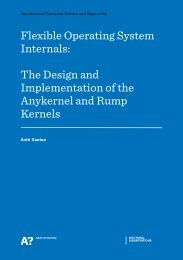Intel SGX Enclave Support in Windows 10 Fall Update (Threshold 2)
1ks6upt
1ks6upt
Create successful ePaper yourself
Turn your PDF publications into a flip-book with our unique Google optimized e-Paper software.
MiInitialize<strong>Enclave</strong>Pfn is used to setup the related MMPFN structure, which is now marked as Modified<br />
and ActiveAndValid.<br />
There are no actual bits at this po<strong>in</strong>t that would help you differentiate this enclave PFN from any other<br />
active region of memory (such as non-paged pool). As you can probably imag<strong>in</strong>e, this is where the<br />
Mi<strong>Enclave</strong>Regions AVL tree comes <strong>in</strong>to play, and MI_PFN_IS_ENCLAVE is a function that the kernel will<br />
use whenever it needs to check if a PFN is <strong>in</strong>deed describ<strong>in</strong>g an EPC region.<br />
With the PFN <strong>in</strong>itialized, the system PTE is now converted to a f<strong>in</strong>al global kernel PTE, and its result<strong>in</strong>g<br />
virtual address is computed (you can always convert a virtual address <strong>in</strong>to a PTE, and vice-versa, on<br />
W<strong>in</strong>dows, s<strong>in</strong>ce all PTEs are mapped <strong>in</strong> a flat array).<br />
The memory manager has now completed its part of the work! What happens next is a call to<br />
KeCreate<strong>Enclave</strong>, which will now do the low-level kernel enclave creation steps, <strong>in</strong>clud<strong>in</strong>g communication<br />
with the actual <strong>SGX</strong> hardware implementation.<br />
The memory manager passes the virtual address of the control area (from the PTE above), the size and<br />
virtual address of the enclave memory <strong>in</strong> user-mode, and a flag specify<strong>in</strong>g whether or not this process is<br />
a WoW64 process, which will be needed shortly.<br />
KeCreate<strong>Enclave</strong> now creates the <strong>SGX</strong>-required PAGEINFO structure. Aga<strong>in</strong>, you should refer to the <strong>Intel</strong><br />
<strong>SGX</strong> Manual for more <strong>in</strong>formation, but suffice it to say that this structure is the implicit <strong>in</strong>put structure to<br />
most of <strong>Intel</strong>’s <strong>SGX</strong> <strong>in</strong>structions. Before do<strong>in</strong>g so however, it parses the SECS structure and performs a<br />
few validation checks.<br />
First, if KeFeatureBits does not have the KF_<strong>SGX</strong> bit set (mean<strong>in</strong>g the kernel did not detect <strong>SGX</strong> support<br />
at boot), the function fails. You’ll see this pattern repeated many times, and it has to do with the fact that<br />
Ke’s job is to potentially support multiple types of hardware enclave features, so <strong>in</strong> the future it may use<br />
the feature bits to decide which hardware implementation to use (or to determ<strong>in</strong>e <strong>SGX</strong>2 vs <strong>SGX</strong>1 support.<br />
Next, you’ll remember that the documented API provides the ability to <strong>in</strong>put the size of the enclave. Well,<br />
so does the SECS structure, and KeCreate<strong>Enclave</strong> will validate that these are the same value. Next, the<br />
Attributes field of the SECS will be verified – specifically, if this is a WoW64 process, then the MODE64BIT<br />
attribute will not be allowed.<br />
Conversely, if this is a 64-bit process, the MODE64BIT attribute is enforced. If you were th<strong>in</strong>k<strong>in</strong>g of us<strong>in</strong>g<br />
64-bit enclaves <strong>in</strong> a WoW64 process for stealth cross-architecture code execution, th<strong>in</strong>k aga<strong>in</strong>.<br />
Next, s<strong>in</strong>ce the caller may have requested the typical behavior of hav<strong>in</strong>g the kernel select the base address<br />
for the allocation, they would not have been able to fill out the pre-requisite BASEADDR field of the SECS,<br />
so KeCreate<strong>Enclave</strong> takes care of fill<strong>in</strong>g out this data.<br />
F<strong>in</strong>ally, if the DEBUG attribute has been set <strong>in</strong> the SECS, the function sets a special flag on output, which<br />
MiCreate<strong>Enclave</strong> will consume. At this po<strong>in</strong>t, the validation and completion of the SECS has been<br />
completed, and the PAGEINFO structure will be created.<br />
You can see its structure, for reference, below.









